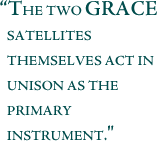

The Workings of GRACE GRACE is different from most Earth observing satellite missions—Terra and Aqua for example—because it doesn’t carry a suite of independent scientific instruments on board. It does not make measurements of the electromagnetic energy reflected back to it from the Earth’s surface. Instead, the two GRACE satellites themselves act in unison as the primary instrument. Changes in the distance between the twin satellites are used to make gravitational field measurements.
The two identical satellites orbit one behind the other in the same orbital plane at approximate distance of 220 kilometers (137 miles). As the pair circles the Earth, areas of slightly stronger gravity (greater mass concentration) affect the lead satellite first, pulling it away from the trailiing satellite. As the satellites continue along their orbital path, the trailing satellite is pulled toward the lead satellite as it passes over the gravity anomaly. The change in distance would certainly be imperceptible to our eyes, but an extremely precise microwave ranging system on GRACE detects these minuscule changes in the distance between the satellites. A hightly accurate measuring device known as an accelerometer, located at each satellite’s center of mass, measures the non-gravitational accelerations (such as those due to atmospheric drag) so that only accelerations cased by gravity are considered. Satellite Global Positioning Syste (GPS) receivers determine the exact position of the satellite over the Earth to within a centimeter or less. Members of the GRACE science team can download all this information from the satellites, and use it to construct monthly maps of the Earth’s average gravity field during the planned five-year mission. next: Key Spacecraft
Components |

GRACE The positions of the two GRACE satellites change in response to variations in Earth’s gravity field. When the two spacecraft pass over the ocean, the distance between them is unchanged (first panel). But when the lead spacecraft encounters a change in gravity over a denser land mass (second panel), it pulls away from the trailing spacecraft, which is still over water. The lead spacecraft moves back over water (third panel), but now the trailing spacecraft changes position in response to the greater pull of gravity over the land mass. The drawings are not to scale. In reality, the GRACE satellites are spaced about 220 kilometers apart, and changes in distance between them would be undetectable by human eyes. GRACE has an onboard microwave-ranging system that makes precise, continuous measurements of the distance between the two spacecraft as they orbit the Earth. |